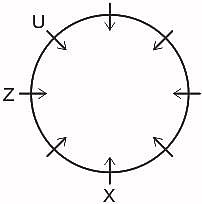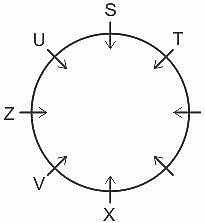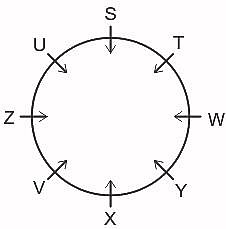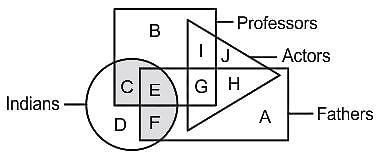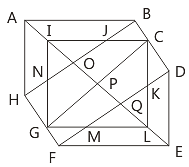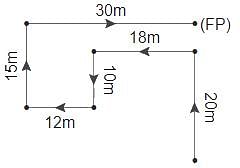Maths & Logical Reasoning Test - 6 - SSC CGL MCQ
30 Questions MCQ Test - Maths & Logical Reasoning Test - 6
P and Q started a business with investment of Rs. 2400 and Rs. 3600 respectively. If at the end of 3 years Q withdraws Rs. 1800, then what is the ratio of profit share of P to Q at the end of 5 year?
Three dices are rolled down simultaneously, then what is probability of getting a sum of 5?
| 1 Crore+ students have signed up on EduRev. Have you? Download the App |
The radius of a circle with centre O is √50 cm. A and C two points on the circle, and B is a point inside the circle. The length of AB is 6 cm, and the length of BC is 2 cm. The angle ABC is a right angle. Find the square of the distance OB.
Consider the following :
1.  = sin A + cos A
= sin A + cos A
2. (1 - sin A - cos A)2 = 2(1 - sin A)(1 + cos A)
Which of the above is/are identity/identities?
If α, β, γ are the zeroes of the polynomial f(x) = ax3 + bx2 + cx + d, then 
The population of 7 villages is shown in the following pie chart.
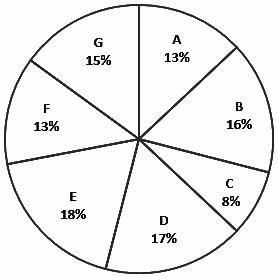
If the total population of all the villages is 60000, what is the population of village G?
The average weight of a class of 14 students increases from 63.8 to 66.5, when 9 new students join the class. What is the average weight of the new students?
Kamal is standing on top of a railway bridge watching an approaching train. The angle of depression of the topmost point of the engine of the train as it comes into sight is 45°. It changes to 60° by the time it comes to a halt. The height of the train is 20 feet and the bridge is 80 feet tall. Find the horizontal distance between the point that the train comes into sight and the point at which it halts (Neglect Kamal's height).
A vessel contains 90 liters of milk. 15 liters of milk were taken out from the vessel and replaced by water. This process was repeated further for two more times. How much milk (approximately in liters) is there in the vessel now?
What is the smallest number by which 2592 must be divided so that the quotient is a perfect cube?
A spherical ball of radius 1.5 cm is dropped into a conical vessel of radius 6 cm and slant height 10 cm. Find the minimum volume (in cm3) of water that can just immerse the ball completely in the vessel.
In the given figure, PM : MR = 2 : 1, RN : NQ = 2 : 1 and PL : LQ = 1 : 2, find the ratio of the shaded area to the un-shaded area.
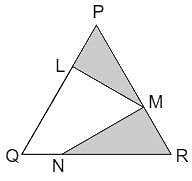
In the following question, select the odd image from the given alternatives.
Seven friends P through V are sitting in a row facing north. P is sitting in the middle. S and T are sitting at alternate places with respect to P. Q and R are at the extreme ends. V is towards the right of U but not immediate right. S is to the immediate right of V and Q is to the immediate right of S. Who is sitting at the second place from the left?
A question is given, followed by two statements numbered (I) and (II). You have to decide whether the data provided in the statements is sufficient to answer the question. Read both the statements and select the appropriate answer.
Question: Eight people J, K, L, M, N, O, P, Q are sitting in a straight line facing north. Who is at third to the right of K?
Statement I: O is fourth to the right of L and 7th to the right of K.
Statement II: Two person sit between K and L and K sits at extreme left end.
Read the given statements and conclusions carefully. Assuming that the information given in the statements is true, even if it appears to be at variance with commonly known facts, decide which of the given conclusions logically follow(s) from the statements.
Statements:
No introvert is an extrovert.
All extroverts are ambiverts.
Conclusions:
I. No introvert is an ambivert.
Il. No ambivert is an introvert.
III. Some ambiverts are extroverts.
IV. All ambiverts are extroverts.
Select the odd group of numbers. (NOTE: Operations should be performed on the whole numbers, without breaking down the numbers into its constituent digits. E.g.13–Operations on 13 such as adding /subtracting /multiplying etc. to 13 can be performed. Breaking down 13 into 1 and 3 and then performing mathematical operations on 1 and 3 is not allowed)
Eight persons are sitting around a circular table facing the centre. Z is an immediate neighbour of both U and V. Z is second to the left of X. S is an immediate neighbour of both U and T. U sits third to the left of X. W is an immediate neighbour of T. Y sits second to the right of V. Who sits third to the left of T?
In the following figure, the triangle represents actors, the square represents professors, the circle represents Indians and the rectangle represents fathers. Which set of letters represents Indians who are either professors or fathers?
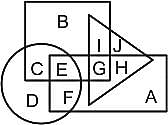
In a code language, PEOPLE is written as OFNQKF. How will SOCIETY be written in same language?
Select the set in which the numbers are related in the same way as are the numbers of the following set.
(13, 8, 3)
If it is possible to make a meaningful word with the second, sixth, eighth, and twelfth letters of the word “ACCIDENTALLY”, which is the second letter of the meaningful English word? If more than one word can be formed then mark your answer as 'Y'. If no such word can be formed then mark your answer as 'M'.
Find out the kids who are watching Doraemon and Shinchan but not Chota Bheem.

Find the number of triangles in the given figure.
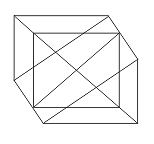
Alokit walked 20 m towards north then turned left and walked 18 m. He then turned to south and walked 10 m then he took a right turn and walked 12 m. After that he turned right and walked 15 m and finally he turned right to and walked 30 m.
In which direction is he now from the starting point?


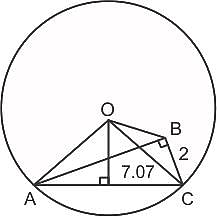











 =
= 
 =
=  {
{ ,
,  }
} =
= 
 Option 3 is correct.
Option 3 is correct. right-angles is equal to
right-angles is equal to
 -
-  )
)


















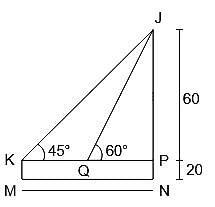









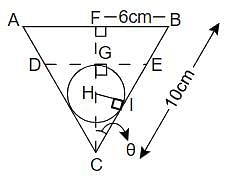









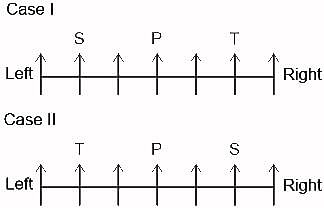






 = Second number
= Second number = Third number
= Third number = Second number
= Second number = Third number
= Third number